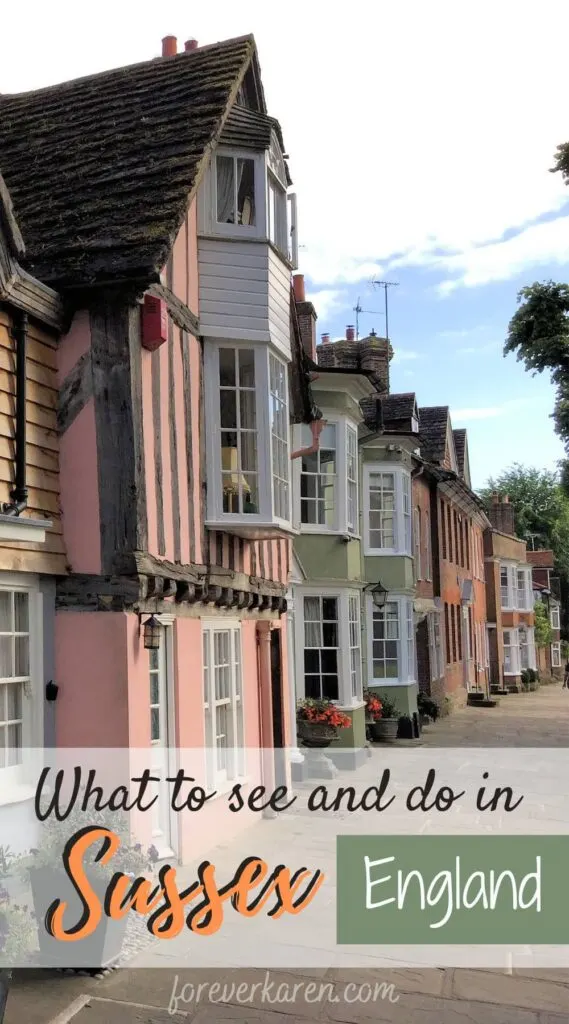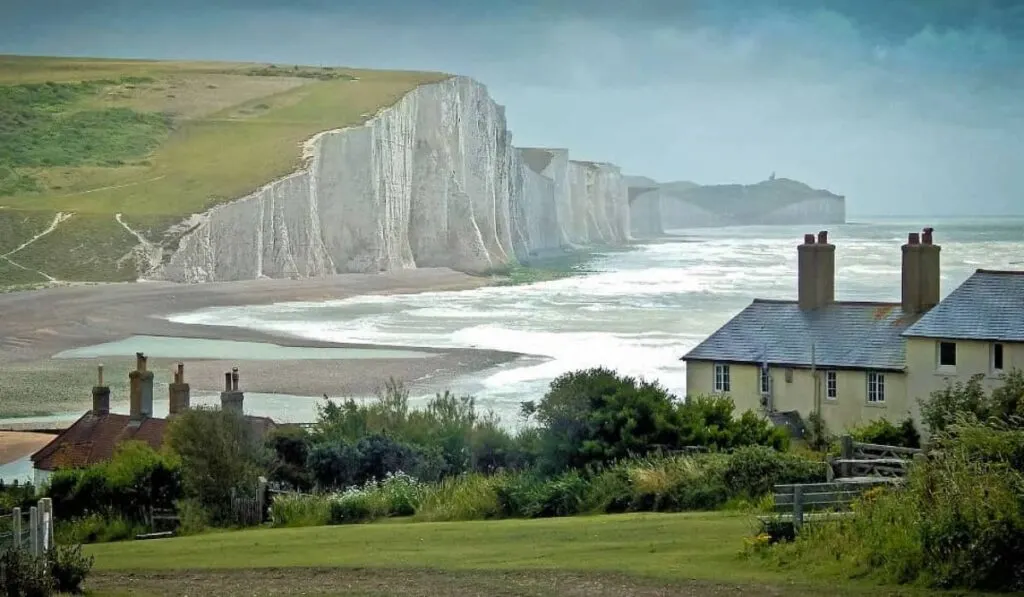
Located in the south of the UK, Sussex comprises a mix of urban, woodlands, wetlands, and 220 km (140 miles) of coastland. Given its easy access by train from London, it allows for some great day trips to explore the South Downs, glorious beaches, and charming towns. There are so many places to visit in Sussex; it’s hard to know where to start.
With the population exploding in England, one of the beauties of Sussex is its undeveloped land. Urban development makes up less than 15%, with the remaining landscape composed of woodland and farmland.
Sussex is divided into two counties, East and West Sussex. Both contain an abundance of small towns, castle ruins, and coastal wonders.
West Sussex
Crawley is the largest town in West Sussex and is located close to Gatwick Airport. The South Downs National Park takes up a good area of the county. Some must-visit towns include Chichester, Horsham, and Arundel.
See Arundel
With a thousand years of history, the market town of Arundel is dominated by the magnificent Arundel Cathedral and an imposing castle. Built in 1868, the Duke of Norfolk ordered the construction of the Gothic church, which later became a cathedral in 1965.
Built next to the impressive Arundel Castle, he wanted a building as impressive as his castle. As imposing as the cathedral is on the outside, it’s relatively small, only seating 500 people.
Arundel Castle and Gardens is the darling of Arundel and maybe the whole of West Sussex. I’ve visited the castle several times, and it’s by far one of the best castles for visitation in the UK.
Not only can you view many of the splendid castle staterooms, but the gardens are a horticultural masterpiece. The castle opens at noon, so should you arrive early, explore the various gardens and visit the Fitzalan Chapel first.
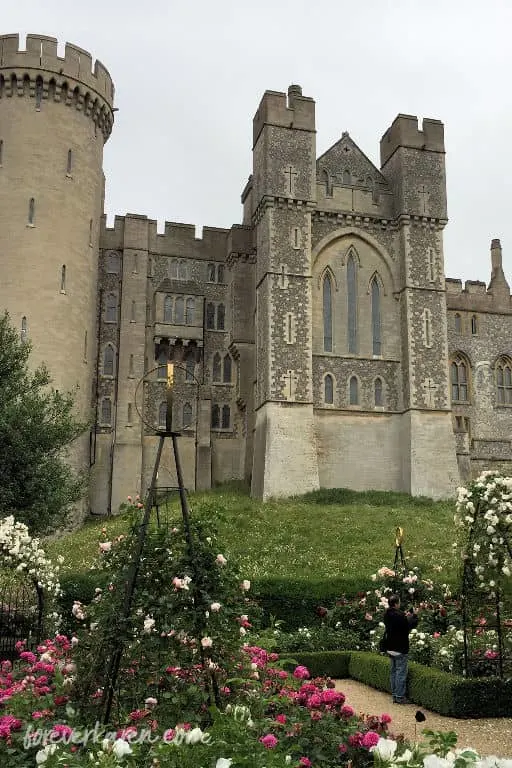
One of the highlights of Arundel Castle is the castle keep. Not only is it the oldest part of the castle, but it’s restored beautifully. After climbing the stairs to the top of the keep, visitors can marvel at the views of the River Arun and the panoramic vistas of the South Downs.
After a visit to the castle, attendees can purchase a reduced-price ticket to Arundel Museum. While small in size, the museum packs a punch with its storyboards and artifacts. One of the boards tells the history of the first train station in Arundel.
Inside the museum, some of the heirlooms are ordinary, like the butter churn and anvil. I found the museum well-organized, and its low admission price makes it perfect for families.
Explore Fishbourne Roman Palace
Fishbourne Roman Palace’s museum showcases some of the best mosaic floors in England. The remains at this magnificent palace are the largest found in Northern Europe. While some of the mosaics remain buried under roads and a building estate, what has been unearthed are excellent specimens.
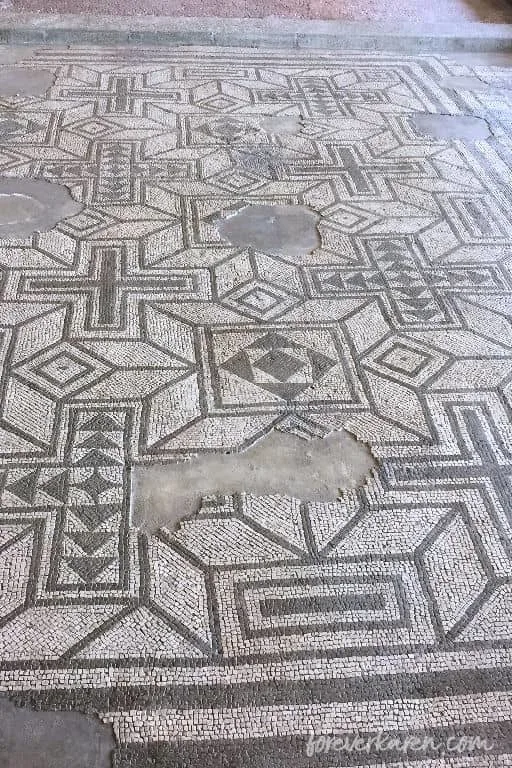
A cavernous building runs over one wing of the vast palace. Outside, stone foundations show the positioning of the other wings. During the self-guided tour, I watched a film documenting the palace’s history and showing what it looked like in its prime.
The mosaics vary from small sections to almost complete floors. Early examples of black and white geometrics were covered with more elaborate designs in more vibrant tones. Much of the colors have faded due to a massive fire at the Fishbourne Palace.
Created in the second century, I found the Cupid on a Dolphin Mosaic breathtaking and in remarkable shape, given its age. Some spaces featured a “doormat,” a different mosaic design welcoming guests into a room.
In another room, a basement hypocaust shows how the Romans heated their palaces. Romans constructed their underground heating systems with channels under the mosaic floors. A furnace channeled the heated gases into the channels creating in-floor heating.
Discovered in 1960, the newly-found Fishbourne Roman Palace is a great place to visit in West Sussex. Its fine mosaic floors are the best I have seen anywhere in England. It’s easily reachable on an outing from Brighton, Worthing or surrounding area.
Visit Chichester
Close to Fishbourne Roman Palace, Chichester retains the charm of a medieval town at the edge of the South Downs. Initially, the compact Sussex town featured four streets that came together and were marked by the Chichester Cross.
Surrounding the city, the Romans built walls, and much of those city walls remain. With a comfortable pair of walking shoes, visitors can walk the 1.5-mile circumference and admire the Roman enclosure.
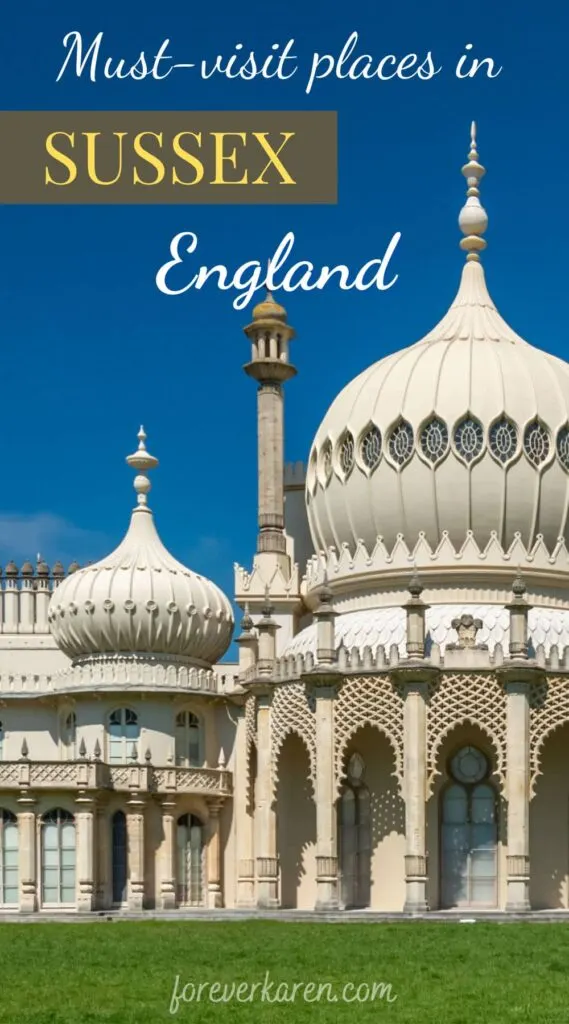
In the heart of the town stands a beautiful cathedral dating from 1075. Chichester Cathedral charges no admission, but gratefully accepts donations.
Close to Chichester, the Goodwood Estate features a 1600 country home that hosts some famous sports events. Each year, the estate hosts the Goodwood Festival of Speed while its Goodwood Racecourse entertains events of the four-legged kind.
Travel To Horsham
As one of the bigger towns in West Sussex, Horsham provides locals with easy access to London by British rail. Its central district features charming buildings from the Georgian and Victorian eras. As my former home for almost five years, I’m partial to Horsham, West Sussex.

The pinnacle of Horsham is the Causeway, a tree-lined street leading to the lovely St. Mary’s Parish Church. As the oldest structure in the town, its building and grounds are worthy of a visit. Travelers can learn more about Horsham’s history at the Horsham Museum and Art Gallery located in the Causeway.
Exploring the Causeway, the buildings’ architecture varies greatly, and some feature historical plaques. On one home, a bronze plaque honors the women who worked there from 1914 to 1918, when it served as the supply depot for the Horsham War Hospital.
The old Town Hall serves as the gateway to the Causeway. Now renovated and turned into a charming restaurant called Bill’s, it serves healthy dishes made from seasonal produce.
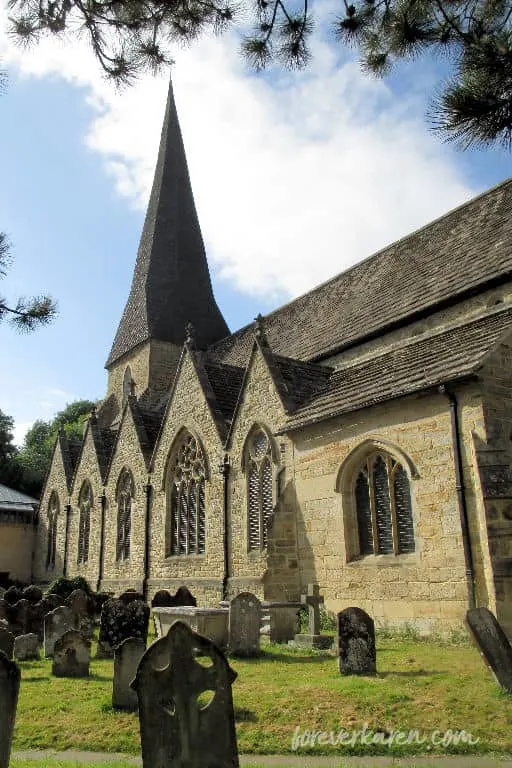
While the building’s interior has been gutted to blend the old with the new, the basement still features the old jail cells. Should you eat there, ask your server to see the holding cells.
Horsham’s most famous resident was Percy Bysshe Shelley, a romantic poet. Born in 1792 in nearby Field Place, Warnham, he later became Mary Shelley’s husband, who wrote the famous book, Frankenstein.
Explore Amberley
If you’re looking for a quiet Sussex village, consider visiting Amberley. Located next to the River Arun, Amberley boasts its own castle and an abundance of charming thatched cottages. Overlooked by most tourists, its small-town feel will charm you with its peaceful persona and fairy-tale disposition.
Amberley Castle is the most iconic structure of the village and is now used as a hotel. Its locale provides picturesque views of the surrounding countryside.
A visit to Amberley isn’t complete without a stop at the Amberley Museum and Heritage Centre. Located next to the railway, I viewed an open-air exhibit featuring old buses, a working print shop, and craftspeople displaying their traditional skills.
Built in 1979 to preserve the industry of the south, the museum serves as a research and education center. Visitors can ride the narrow-gauge railway at the museum, watch the construction of a wagon wheel, and tour the estate on a vintage bus.
Tour Bignor Roman Villa
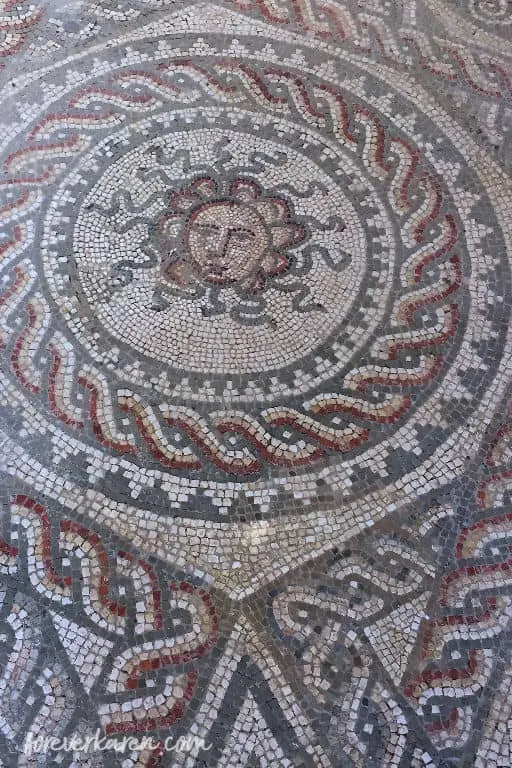
Smaller than Fishbourne Roman Palace, Bignor Roman Villa features a square villa constructed around a courtyard. Found on the Tupper’s family farm, it was discovered by accident when plowing a field.
For hundreds of years, visitors have enjoyed coming to the farm to see the remnants of the medieval Roman Villa. Initially, the villa had 65 rooms, and today the remains are displayed in quaint thatch-roofed cottages.
A small room shows a model of the initial villa and artifacts found on the site. But, the star of the Roman structure is its mosaic floors. Like Fishbourne Roman Palace, this villa features the same hypocaust heating system. However, I admired the complete floor with an intact mosaic.
For historians and archaeologists, the highlight of Bignor is the longest mosaic in England located in the north corridor. Currently measuring 79 feet or 24 meters, two thousand years ago, the complete floor was 230 feet or 70 meters.
Outside, the grounds feature a cold Roman bath and pillar foundations. Inside another cottage, a magnificent Medusa mosaic was the feature of the Roman bathhouse.
East Sussex
Sandwiched between West Sussex and Kent, East Sussex holds its share of British history with the 1066 Battle of Hastings. Its rolling hills are home to various castle ruins and charming villages.
Residents are spoiled with unabated views across the English Channel, beautiful beaches, and chalk cliffs along the coast. So, here are the best places to visit in East Sussex.
Browse Brighton
As a popular English seaside resort, Brighton offers a little of everything. The star attraction of Brighton is the Royal Pavilion, designed by architect John Nash. Located in the center of Brighton, the exotic Palace looks out of place with its Indo-Saracenic shell, prevalent in India.

However, its intricate details exude regency with its grand presence and opulent interior. As for its interior, Nash added elements of Neo-classical, Gothic, and mainly Chinese details. Its over-the-top components are almost kaleidoscopic, from the dragon chandeliers to the palm tree ceilings.
The use of gold is everywhere, to the point of being garish. But at the time of construction, the eclectic style exemplified King George IV’s vision for an opulent English Palace.
For those that prefer a little shopping therapy, The Lanes consist of a colorful collection of boutiques and unique stores. The shops are as eclectic as the Royal pavilion interior but set out in a maze of alleyways that are fun to wander. It’s a great place to purchase some English souvenirs.
The bizarre shoes at Irregular Choice and the fantastic cakes of Choccywoccydoodah particularly impressed me.

Along the waterfront, the British Airways 360’s observation tower offers aerial views of Brighton. The glass passenger pod, which holds up to 200 people, rises 450 feet providing 360-degree views.
To the east of the viewing pod, the Brighton Palace Pier dominates the coastline with its 1899 wooden structure. The Brighton landmark millions of visitors a year to walk its boardwalk, play the amusement arcades, and eat chips amongst the seagulls.
Visitors to Brighton can also ride the Volk’s Electric Railway, a narrow-gauge track that runs along the waterfront. Built in1883, it’s now the oldest operating electric railway in the world. The trains operate from March to October and depart every 15 minutes.
Admire Herstmonceux Castle
Nestled on 300 acres of woodland and gardens, the 15th-century Herstmonceux Castle embodies medieval romance with its unusual red brick and beautiful setting.
While most castles are made of stone, Herstmonceux Castle is the oldest standing brick structure in England. It’s easy to see why tourists are drawn here. The moated castle oozes majestic beauty reflected in the surrounding waters.
In 1992, Alfred Bader purchased the uninhabited castle and opened the Bader International Study Centre. While Canada’s Queen’s University campus remains closed to the public, visitors can explore the extensive grounds and access the castle on a limited guided tour.
View The Seven Sisters

Located along the English Channel, the famous Seven Sisters white cliffs adorn postcards and chocolate boxes. Above the chalk cliffs, the Seven Sisters Country Park provides numerous walking trails and an excellent place for bird watching.
While most people know the cliffs as just the Seven Sisters, each cliff has a name. They are Brass Point, Haven Brow, Rough Brow, Flagstaff Brow, Short Brow, Went Hill Brow, and Bailey’s Brow.
The highest of them, Haven Brow, stands 252 feet or 77 meters and offers terrific views across the channel on a clear day. Like other chalk cliffs along the channel, the elements of nature are slowly eroding the landscape. So, should you visit, stay clear of the edge.
Further east, Beachy Head wows visitors with a similar set of chalk cliffs. At 531 feet or 162 meters, this is the highest chalk cliff in England. From east to west, the cliffs descend to Birling Gap and onto Seven Sisters.
See The Chalk Hill Figures
In the hills of southern England, visitors can find larger-than-life chalk drawings. Carvers made the massive shapes by sculpting into the hillside, revealing the chalk beneath. Known as geoglyphs, they depict animals, people, and symbols.
Artists create positive geoglyphs by placing material on top of the land. Negative geoglyphs are made when carvers remove the top layer of soil, revealing the ground beneath.
In East Sussex, two great examples of these are the White Horse of Litlington and the Long Man of Wilmington. Measuring 28 meters (93 feet) by 20 meters (65 feet), visitors can find the White Horse of Litlington in the South Downs, north of the Seven Sisters.
The earlier horse was carved out in the 1830s, but carvers created the horse seen today almost a hundred years ago.
Located three miles northeast of the White Horse of Litlington, the Long Man of Wilmington equally fascinates visitors with its giant façade. Dating back to the 1700s, the artist created the geoglyph on Windover Hill, and the reasoning for its creation remains a mystery today.
During the Second World War, the state painted the figure green, preventing the enemy from using it as a landmark. So, today, some people still refer to it as the “Green Man.” If you’re looking to visit a place in Sussex, that’s off the beaten path, consider seeing one of these geoglyphs.
See Bodiam Castle
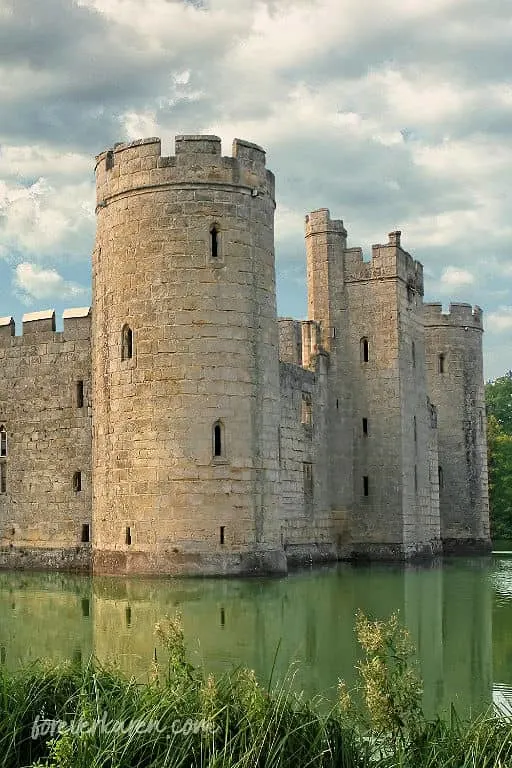
A quintessential British stronghold, Bodiam Castle oozes romanticism with its fairytale moat and picturesque setting. Built by Sir Edward Dalyngrigge in 1385, much of the outer structure appears well-preserved today. However, the courtyard of the castle has not stood the test of time.
From the outside, the structure appears quite large but it’s an optical illusion. Walking inside its walls, I realized the castle is much smaller.
The rectangular castle sits in the middle of the moat, and historians have debated its existence. Some believe it was constructed as a stronghold.
Others say it was built for entertainment purposes since the walls are thin, the windows too small for arrows, and the moat did not act as a deterrent.
We might never know the true purpose of Bodiam Castle; however, its picturesque ruin still begs for a visit. While Britain’s Leeds Castle might be considered the world’s loveliest castle, Bodiam Castle could arguably be the most romantic castle in England.
Visit The Pevensey Castle Ruins
Believed to date back to AD 290, Pevensey Castle’s early beginnings remain a mystery. While the current castle stands in ruins, the massive perimeter walls suggest the fortress served well as a stronghold.
Once located by the ocean, William the Conqueror landed here in preparation for the Battle of Hastings in 1066. Today, the castle sits on a hill in Pevensey, a mile from the beachfront.
As the largest remaining shorefront Saxon fort, this is a place that begs for exploration. Inside the large curtain wall, there’s not much left of the castle. Admission includes an audio tour and access to the dungeon where a museum documents the castle’s history.
During the 15th century, the castle served as a prison. Then, in 1925, the last owner, the Duke of Devonshire, gave the fortress to the state. During World War II, the military added machine-gun posts on top of the walls, with one still visible today.
Although the castle is ruinous, it’s fun to climb the outer walls for spectacular courtyard views. Visitors can also enjoy the remains of the towers, see the cannons and view a pile of stone catapult balls removed from the moat.
Explore Battle Abbey

For a great day out, be sure to visit Battle for a fantastic history lesson. The famous Battle of Hastings in 1066 took place in Battle, East Sussex.
William the Conqueror and King Harold fought bravely with their armies, which resulted in King Harold’s death.
After the conflict, the state built Battle Abbey as a memorial to those that lost their lives. Today, visitors can tour Battle Abbey and see the spot where King Harold fell.
While much of the original buildings are in ruins, the gatehouse and monk’s dormitory are well preserved. The Abbey ruins are spectacular, well maintained, and offer lots of informational plaques about the Battle of Hastings.
Nearby, the battlefield trail offers a peaceful stroll amongst the wildflowers, a stark contrast to the conflicting event centuries ago. The audio tour is a must because it recounts the story of the famous battle as you view the carved wooden soldiers in the field.
Final Thoughts
Home to rolling hills, quaint villages, and a picturesque coastline, Sussex provides a great retreat from the hustle and bustle of London. Many of the towns and villages are accessible by British rail, so day trips are possible from the capital if you have no vehicle.
There is plenty to see and do, and with a variety of attractions, visitors can choose between a peaceful day or a busy, fun-filled one. So, immerse yourself in the history of Sussex and enjoy what was once my home.
